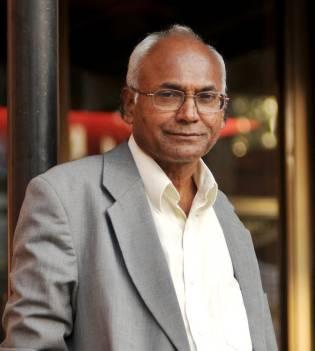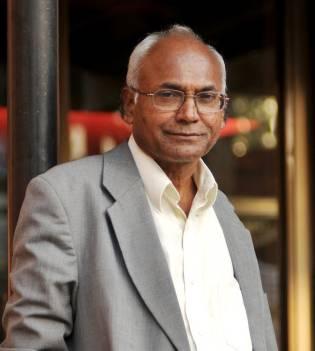Kancha Ilaiah
 I am among the millions who live a life without a birthday. October 5, 1952 is what my school recorded as my birthday; beyond this, I am as yet unclear of it all. As I retire this month from Osmania University, where I studied, researched and taught over a period of 38 years, it may be of some value to now tell the story of Osmania and of mine.
I am among the millions who live a life without a birthday. October 5, 1952 is what my school recorded as my birthday; beyond this, I am as yet unclear of it all. As I retire this month from Osmania University, where I studied, researched and taught over a period of 38 years, it may be of some value to now tell the story of Osmania and of mine.
Osmania is an old village-like university established by Osman Ali Khan in 1918. He did that at a time when millions of Telanganites didn’t know who their ruler was and what a university would be. The first and deepest impression of the imposing Arts College building that was built with marble brought here from abroad is still fresh in my memory. I first saw it, and also the imposing portrait of Osman Ali Khan in the library building, as I came to take the entrance test for MA. It was in 1974.
Like many others, I was also a victim of the 1969 Telangana agitation and the mass copying that accompanied it. But for the newly introduced entrance, where no copying was allowed, I would not have got a seat in this university. When I first saw the Arts college, the building looked amazing. But when I saw the portrait of the man who built that, I was further surprised. He looked as dark as I was, carrying the innocence of the region on his face. He was said to be a scholar in his own right.
Those were the days of the militant Naxalite movement. Naturally, those of us who came from the oppressed communities preferred the radical left-wing student organisation, the Progressive Democratic Students Union, to the rightwing Akhil Bharatiya Vidhyarthi Parishad. Our slogan was ‘Study and Struggle’. Their slogan was ‘Vandemataram.’
Till the Emergency was imposed on June 26, 1975, the Naxalbari ‘Spring Thunder’ was ringing in our years. Many in our circles took the ‘study’ part of the slogan as moralistic, and the ‘struggle’ part as being a more serious pursuit. One of the revolutionary songs my friends used to sing at every meeting was Nee Gori Kadatham Kodako Nizam Sarkaroda (O Bloody Nizam, we will kill you, and build a tomb). The right wing students used to circulate funny stories about his evil deeds. What I realised later was that he was a man of vision and held dreams of modern education.
We were under the illusion that the Naxalite movement would liberate the villages, encircle the cities and finally the New Democratic State will be established. Mao would, then, become our chairman also.
Quite funnily, the emergency, which we hated all long, became our classroom conductor. Some radicals went underground, a few were killed in encounters, but some of us turned to serious study. I was one of the beneficiaries of the timid side of Marxism which used to insist that study at least when you cannot struggle. The atmosphere was mediocre, with slogans and songs all around. If there was any writer, he/she would write some poems about the power of the gun and the flow of blood. English was meant for the classroom and Telugu for revolution. I was fortunate enough to get out of that dogma slowly as I became a teacher in that very marble building.
Over the years, I formulated a slogan of my own life, “Read, Write and Fight”. The first two parts of the slogan were alien to our lifestyle, family and caste history. On the home front, we never knew what reading and writing were. Fighting was part of our house, street and village. But my new slogan needed to be executed first at a personal level, going beyond what is required of the professional reading and writing. I tried, therefore, to expand my personal reading and writing with a methodology of my own: combining the “academic” and the “popular.” The environment of Osmania was not known for that. Along with that, I could turn the classroom a creative zone.
Somewhere I had read that Dr Sarvepalli Radhakrishnan once visited the Arts College building and remarked, “This marble building so far did not produce an academic marble.” I was also told that he had no appreciation for the Nizam. For him, an ‘academic marble’ would be one that engraves his philosophical image of India.
I chose to be a black stone among white marbles that wrote the Indian philosophical history upside down. I became a buffalo scholar loving English and living in it day and night. Fortunately, the powers that ruled the university never interfered with my independent pursuit of knowledge, except once when they gave a letter, asking me to observe some limits while writing.
I loved the university’s rural environment. I could easily shift the methodology of discourse from ‘writing a book from other books,’ or writing about militant movements — Telangana Armed Struggle, Naxalbari etc — to writing the philosophy of a people’s day-to-day life. There was this moribund academic view that masses do not have a philosophy of their own. In a way, I proved they have. The borrowed wisdom (from the West) was that either a metaphysical realm or a materialist realm could engage with the philosophy of social science. I came to the conclusion that even the Indian illiterate lower caste masses produce knowledge around ‘Spiritual Materialism’ within their productive field.
While leaving the university, I must say I did my job. I am neither happy nor unhappy. Any university can produce a serious thought only when the ideas that got generated by one generation of scholars are improved, modified and advanced by the next generation. I hope the process will continue.
~~~
[Courtesy: Deccan Chronicle, October 1, 2012]









